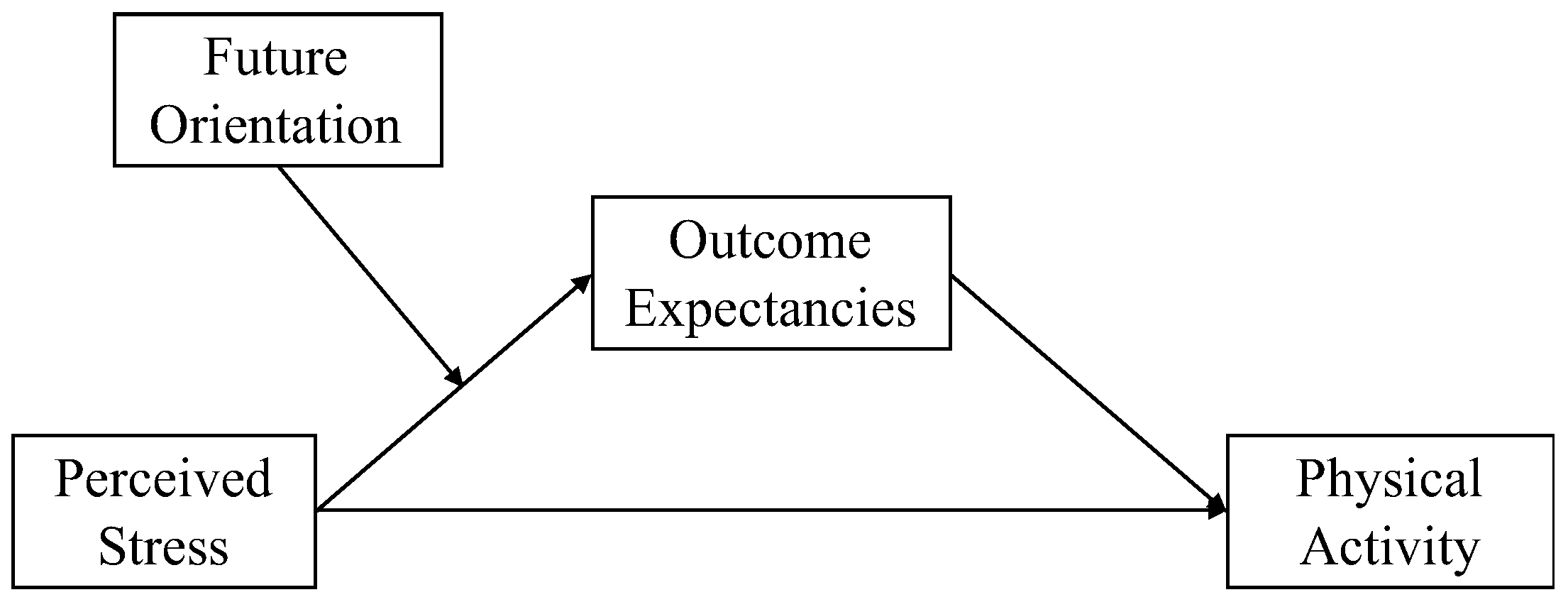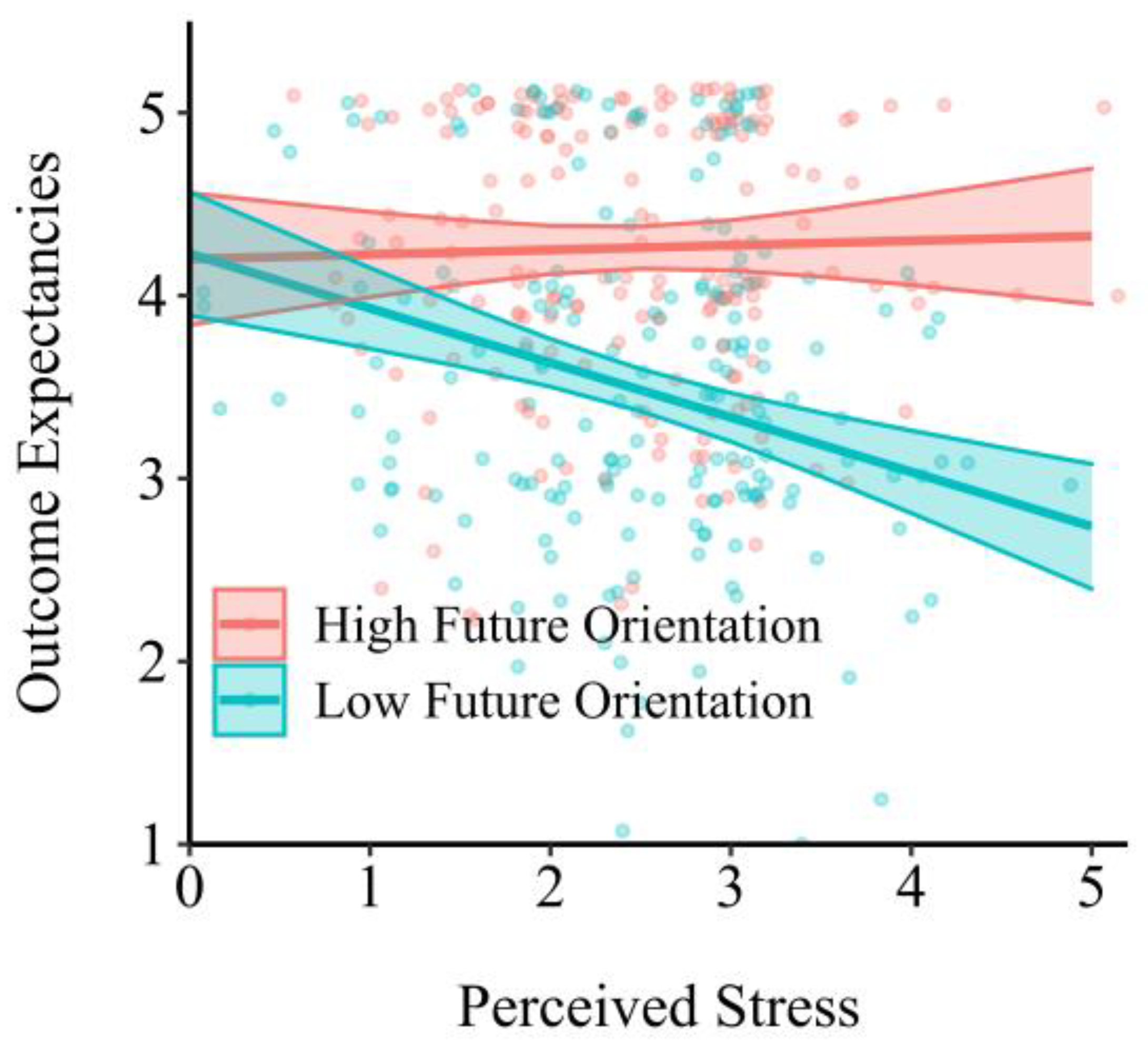Physical Activity under Stress: A Perspective of HAPA and Individual Differences
Abstract
:1. Introduction
1.1. Literature Review
1.1.1. Perceived Stress and Physical Activity
1.1.2. Outcome Expectancies
1.1.3. Future Orientation
1.2. The Present Study
2. Methods
2.1. Participants
2.2. Measures
2.2.1. Perceived Stress
2.2.2. Physical Activity
2.2.3. Outcome Expectancies
2.2.4. Future Orientation
3. Results
3.1. Attrition Analysis
3.2. Mediating Effect of Outcome Expectancies
3.3. Moderating Effect of Future Orientation
4. Discussion
4.1. Outcome Expectancies Explain Associations between Perceived Stress and Physical Activity
4.2. Future Orientation Alters Effects of Perceived Stress on Outcome Expectancies
4.3. Implications
4.4. Limitations
5. Conclusions
Author Contributions
Funding
Institutional Review Board Statement
Informed Consent Statement
Data Availability Statement
Acknowledgments
Conflicts of Interest
References
- Wu, X.; Tao, S.; Zhang, Y.; Zhang, S.; Tao, F. Low physical activity and high screen time can increase the risks of mental health problems and poor sleep quality among Chinese college students. PLoS ONE 2015, 10, e0119607. [Google Scholar] [CrossRef] [PubMed] [Green Version]
- Jao, N.C.; Robinson, L.D.; Kelly, P.J.; Ciecierski, C.C.; Hitsman, B. Unhealthy behavior clustering and mental health status in United States college students. J. Am. Coll. Health 2019, 67, 790–800. [Google Scholar] [CrossRef]
- Stults-Kolehmainen, M.A.; Sinha, R. The effects of stress on physical activity and exercise. Sports Med. 2014, 44, 81–121. [Google Scholar] [CrossRef]
- Zhang, C.-Q.; Zhang, R.; Schwarzer, R.; Hagger, M.S. A meta-analysis of the health action process approach. Health Psychol. 2019, 38, 623–637. [Google Scholar] [CrossRef] [PubMed] [Green Version]
- Zheng, L.; Luszczynska, A.; Miao, M.; Chen, Y.; Gan, Y. Effects of environmental worry on fruit and vegetable intake. Int. J. Behav. Med. 2021. [Google Scholar] [CrossRef] [PubMed]
- Shimizu, Y. Development of a stress management behaviour model based on HAPA for Japanese high school students. Eur. Health Psychol. 2016, 18, 930. [Google Scholar]
- Childs, E.; de Wit, H. Regular exercise is associated with emotional resilience to acute stress in healthy adults. Front. Physiol. 2014, 5, 161. [Google Scholar] [CrossRef]
- Schwarzer, R.; Lippke, S.; Luszczynska, A. Mechanisms of health behavior change in persons with chronic illness or disability: The health action process approach (HAPA). Rehabil. Psychol. 2011, 56, 161. [Google Scholar] [CrossRef] [PubMed]
- Rodriquez, E.J.; Gregorich, S.E.; Livaudais-Toman, J.; Pérez-Stable, E.J. Coping with chronic stress by unhealthy behaviors: A re-evaluation among older adults by race/ethnicity. J. Aging Health 2017, 29, 805–825. [Google Scholar] [CrossRef]
- Lutz, R.S.; Stults-Kolehmainen, M.A.; Bartholomew, J.B. Exercise caution when stressed: Stages of change and the stress–exercise participation relationship. Psychol. Sport Exerc. 2010, 11, 560–567. [Google Scholar] [CrossRef]
- Cruz, S.Y.; Fabian, C.; Pagan, I.; Rios, J.L.; Gonzalez, A.M.; Betancourt, J.; González, M.J.; Rivera-Soto, W.T.; Palacios, C. Physical activity and its associations with sociodemographic characteristics, dietary patterns, and perceived academic stress in students attending college in Puerto Rico. P. R. Health Sci. J. 2013, 32, 44–50. [Google Scholar]
- Föhr, T.; Pietilä, J.; Helander, E.; Myllymäki, T.; Lindholm, H.; Rusko, H.; Kujala, U.M. Physical activity, body mass index and heart rate variability-based stress and recovery in 16 275 Finnish employees: A cross-sectional study. BMC Public Health 2016, 16, 701. [Google Scholar] [CrossRef] [PubMed] [Green Version]
- Munóz-Jiménez, J.; Rojas-Valverde, D.; Leon, K. Future challenges in the assessment of proprioception in exercise sciences: Is imitation an alternative? Front. Hum. Neurosci. 2021, 15, 664667. [Google Scholar] [CrossRef]
- Vandevala, T.; Pavey, L.; Chelidoni, O.; Chang, N.-F.; Creagh-Brown, B.; Cox, A. Psychological rumination and recovery from work in intensive care professionals: Associations with stress, burnout, depression and health. J. Intensive Care 2017, 5, 16. [Google Scholar] [CrossRef] [PubMed] [Green Version]
- Meyer, S.; Larson, M. Physical activity, stress, and academic performance in college: Does exposure to stress reduction information make a difference? J. Coll. Stud. Psychother. 2018, 52, 452–457. [Google Scholar]
- Wunsch, K.; Kasten, N.; Fuchs, R. The effect of physical activity on sleep quality, well-being, and affect in academic stress periods. Nat. Sci. Sleep 2017, 9, 117. [Google Scholar] [CrossRef] [Green Version]
- Bize, R.; Johnson, J.A.; Plotnikoff, R.C. Physical activity level and health-related quality of life in the general adult population: A systematic review. Prev. Med. 2007, 45, 401–415. [Google Scholar] [CrossRef] [PubMed]
- Brockmann, A.N.; Ross, K.M. Bidirectional association between stress and physical activity in adults with overweight and obesity. J. Behav. Med. 2020, 43, 246–253. [Google Scholar] [CrossRef] [PubMed]
- Throne, L.C.; Bartholomew, J.B.; Craig, J.; Farrar, R.P. Stress reactivity in fire fighters: An exercise intervention. Int. J. Stress Manag. 2000, 7, 235–246. [Google Scholar] [CrossRef]
- Schwarzer, R. Modeling health behavior change: How to predict and modify the adoption and maintenance of health behaviors. Appl. Psychol. 2008, 57, 1–29. [Google Scholar] [CrossRef]
- McEwen, B.S. Physiology and neurobiology of stress and adaptation: Central role of the brain. Physiol. Rev. 2007, 87, 873–904. [Google Scholar] [CrossRef] [PubMed] [Green Version]
- Roux, C.; Goldsmith, K.; Bonezzi, A. On the psychology of scarcity: When reminders of resource scarcity promote selfish (and generous) behavior. J. Consum. Res. 2015, 42, 615–631. [Google Scholar] [CrossRef]
- Perrier, M.-J.; Sweet, S.N.; Strachan, S.M.; Latimer-Cheung, A.E. I act, therefore I am: Athletic identity and the health action process approach predict sport participation among individuals with acquired physical disabilities. Psychol. Sport Exerc. 2012, 13, 713–720. [Google Scholar] [CrossRef]
- Reiner, M.; Niermann, C.; Jekauc, D.; Woll, A. Long-term health benefits of physical activity–a systematic review of longitudinal studies. BMC Public Health 2013, 13, 813. [Google Scholar] [CrossRef] [Green Version]
- Gordon-Larsen, P.; Hou, N.; Sidney, S.; Sternfeld, B.; Lewis, C.E.; Jacobs, D.R., Jr.; Popkin, B.M. Fifteen-year longitudinal trends in walking patterns and their impact on weight change. Am. J. Clin. Nutr. 2009, 89, 19–26. [Google Scholar] [CrossRef] [Green Version]
- Qi, M.; Li, P.; Moyle, W.; Weeks, B.; Jones, C. Physical activity, health-related quality of life, and stress among the Chinese adult population during the COVID-19 pandemic. Int. J. Environ. Res. Public Health 2020, 17, 6494. [Google Scholar] [CrossRef]
- Miller, S.M.; Siegel, J.T. Youth sports and physical activity: The relationship between perceptions of childhood sport experience and adult exercise behavior. Psychol. Sport Exerc. 2017, 33, 85–92. [Google Scholar] [CrossRef]
- Gan, Y.; Miao, M.; Zheng, L.; Liu, H. Temporal Doppler effect and future orientation: Adaptive function and moderating conditions. J. Pers. 2017, 85, 313–325. [Google Scholar] [CrossRef] [PubMed]
- Orbell, S.; Kyriakaki, M. Temporal framing and persuasion to adopt preventive health behavior: Moderating effects of individual differences in consideration of future consequences on sunscreen use. Health Psychol. 2008, 27, 770. [Google Scholar] [CrossRef] [Green Version]
- Adams, J.; Nettle, D. Time perspective, personality and smoking, body mass, and physical activity: An empirical study. Br. J. Health Psychol. 2009, 14, 83–105. [Google Scholar] [CrossRef] [PubMed] [Green Version]
- Chapman, G.B. Short-term cost for long-term benefit: Time preference and cancer control. Health Psychol. 2005, 24, S41–S48. [Google Scholar] [CrossRef] [Green Version]
- Joireman, J.; Shaffer, M.J.; Balliet, D.; Strathman, A. Promotion orientation explains why future-oriented people exercise and eat healthy: Evidence from the two-factor consideration of future consequences-14 scale. Pers. Soc. Psychol. 2012, 38, 1272–1287. [Google Scholar] [CrossRef] [PubMed] [Green Version]
- Zhou, G.; Gan, Y.; Knoll, N.; Schwarzer, R. Proactive coping moderates the dietary intention–planning–behavior path. Appetite 2013, 70, 127–133. [Google Scholar] [CrossRef] [PubMed]
- Zheng, L.; Lippke, S.; Chen, Y.; Li, D.; Gan, Y. Future orientation buffers depression in daily and specific stress. Psych. J. 2019, 8, 342–352. [Google Scholar] [CrossRef]
- MacLeod, A.K.; Conway, C. Well-being and the anticipation of future positive experiences: The role of income, social networks, and planning ability. Cogn. Emot. 2005, 19, 357–374. [Google Scholar] [CrossRef] [PubMed]
- Ortner, C.N.; Chadwick, L.; Wilson, A.M. Think ahead before you regulate: A focus on future consequences predicts choices of and beliefs about strategies for the down-regulation of negative emotions. Motiv. Emot. 2018, 42, 896–908. [Google Scholar] [CrossRef]
- Folkman, S.; Moskowitz, J.T. Coping: Pitfalls and promise. Annu. Rev. Psychol. 2004, 55, 745–774. [Google Scholar] [CrossRef] [PubMed]
- Schüz, N.; Schüz, B.; Eid, M. Adding perspective: Predicting adolescent sunscreen use with an extended health action process approach. Appl. Psychol. Health Well-Being 2016, 8, 155–171. [Google Scholar] [CrossRef]
- Cohen, S.; Kamarck, T.; Mermelstein, R. A global measure of perceived stress. J. Health Soc. Behav. 1983, 24, 385–396. [Google Scholar] [CrossRef]
- Schwarzer, R. Health action process approach (HAPA) as a theoretical framework to understand behavior change. Actual. Psicol. 2016, 30, 119–130. [Google Scholar] [CrossRef]
- Strathman, A.; Gleicher, F.; Boninger, D.S.; Edwards, C.S. The consideration of future consequences: Weighing immediate and distant outcomes of behavior. J. Pers. Soc. Psychol. 1994, 66, 742–752. [Google Scholar] [CrossRef]
- Atlantis, E.; Chow, C.-M.; Kirby, A.; Singh, M.F. An effective exercise-based intervention for improving mental health and quality of life measures: A randomized controlled trial. Prev. Med. Rep. 2004, 39, 424–434. [Google Scholar] [CrossRef]
- Boals, A.; Banks, J.B. Stress and cognitive functioning during a pandemic: Thoughts from stress researchers. Psychol. Trauma 2020, 12, S255–S257. [Google Scholar] [CrossRef] [PubMed]
- Maslow, A.H. A theory of human motivation. Psychol. Rev. 1943, 50, 370–396. [Google Scholar] [CrossRef] [Green Version]
- Zhang, N.; Kou, Y. Implicit theories of health, consideration of future consequences, and engagement in health protective behaviors during the COVID-19 pandemic in China. J. Health Psychol. 2021, 5, 13. [Google Scholar] [CrossRef]



Publisher’s Note: MDPI stays neutral with regard to jurisdictional claims in published maps and institutional affiliations. |
© 2021 by the authors. Licensee MDPI, Basel, Switzerland. This article is an open access article distributed under the terms and conditions of the Creative Commons Attribution (CC BY) license (https://creativecommons.org/licenses/by/4.0/).
Share and Cite
Zhou, S.; Li, L.; Zhao, Y.; Cao, Y.; Peng, B.; Zheng, L. Physical Activity under Stress: A Perspective of HAPA and Individual Differences. Int. J. Environ. Res. Public Health 2021, 18, 12144. https://doi.org/10.3390/ijerph182212144
Zhou S, Li L, Zhao Y, Cao Y, Peng B, Zheng L. Physical Activity under Stress: A Perspective of HAPA and Individual Differences. International Journal of Environmental Research and Public Health. 2021; 18(22):12144. https://doi.org/10.3390/ijerph182212144
Chicago/Turabian StyleZhou, Song, Linqian Li, Yan Zhao, Yiheng Cao, Baozhong Peng, and Lei Zheng. 2021. "Physical Activity under Stress: A Perspective of HAPA and Individual Differences" International Journal of Environmental Research and Public Health 18, no. 22: 12144. https://doi.org/10.3390/ijerph182212144
APA StyleZhou, S., Li, L., Zhao, Y., Cao, Y., Peng, B., & Zheng, L. (2021). Physical Activity under Stress: A Perspective of HAPA and Individual Differences. International Journal of Environmental Research and Public Health, 18(22), 12144. https://doi.org/10.3390/ijerph182212144




